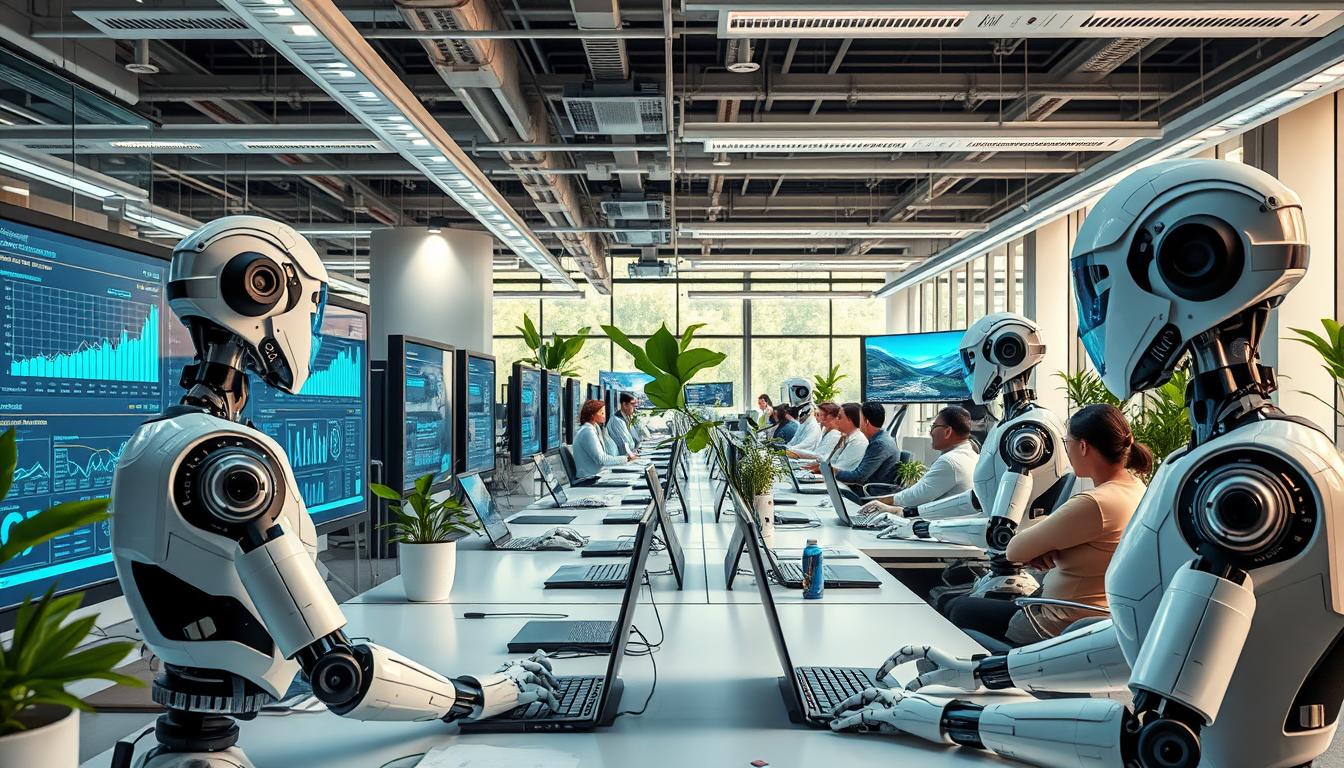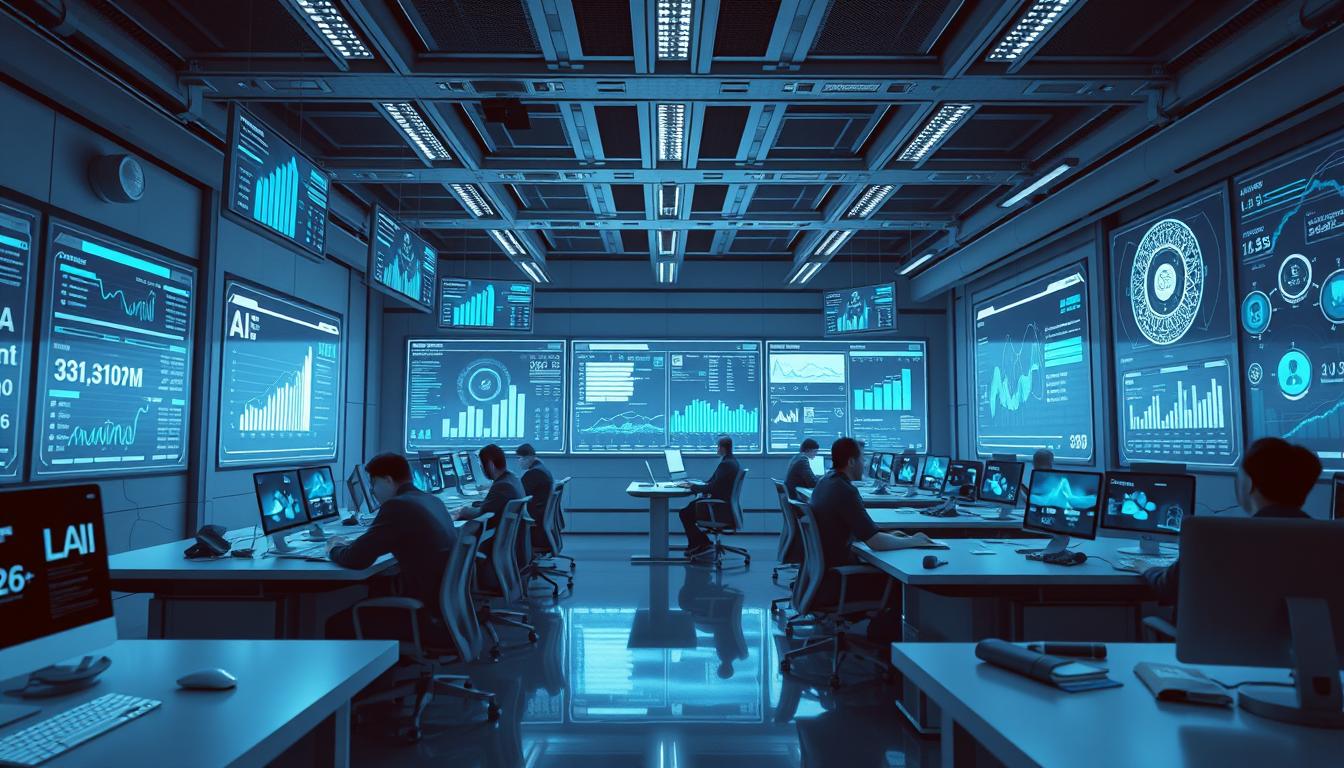In today’s fast-paced business world, AI employee monitoring is revolutionizing how companies manage their teams. Giants like Walmart, Starbucks, and Delta are adopting cutting-edge tools, including Aware, to evaluate employee performance and actions in real-time. This shift brings up critical issues about productivity, privacy, and employee happiness. It’s vital to grasp the impact of such surveillance software on daily work life.
Exploring the intricacies and uses of AI in monitoring employees, you’ll uncover current trends and practices. You’ll also see the benefits and hurdles this technology brings. This knowledge is essential for understanding the future of workplace monitoring.
Key Takeaways
- AI employee monitoring is increasingly used by major companies such as Walmart and Starbucks.
- 75% of cybersecurity threats originate from non-malicious insiders, emphasizing the need for robust monitoring.
- 45% of employees experience negative mental health effects due to monitoring technologies.
- 74% believe that traditional productivity metrics need improvement.
- Legal and regulatory frameworks for AI in the workplace are still developing.
- AI is projected to save employees significant time, enhancing productivity.
Understanding AI in the Workplace
The integration of artificial intelligence into workplace practices is a significant shift. It transforms how organizations operate. AI technologies are revolutionizing digital workforce management by creating a robust framework for assessing employee behavior analysis. Algorithms and machine learning processes enable companies to collect and analyze extensive data on employee activities. This offers insights that were previously unattainable.
A Goldman Sachs study suggests that AI could substitute up to one-fourth of current work. This highlights the potential of these technologies. The efficiency gained through AI-driven monitoring tools often leads to improved productivity and a more engaged workforce. An Eightfold AI survey from 2022 showed that nearly 75% of U.S. companies were already using AI for recruitment, hiring, and performance management. This evidence underscores its growing significance in human resources.
AI is increasingly employed in sentiment analysis, helping organizations gauge employee well-being. The emphasis on ethical standards and compliance is crucial. This is especially true given the potential for “disparate impact” discrimination, as noted by the EEOC in May 2023. Tools that analyze productivity must be regularly monitored by human oversight to ensure adherence to the Fair Labor Standards Act (FLSA), according to guidance from the DOL.
As you consider the role of AI in the workplace, it’s important to recognize that these systems also come with regulations. Colorado’s Artificial Intelligence Act is a prime example, imposing obligations on employers using high-risk AI systems. These measures are designed to mitigate algorithmic discrimination, ensuring that all employees are treated fairly.

Current Trends in AI Employee Monitoring
The landscape of AI Employee Monitoring is rapidly evolving as businesses seek to boost workplace efficiency and drive employee productivity. Notable trends are emerging in response to the demands of a changing workforce environment. One significant trend is the marked increase in funding for workplace technologies related to performance management, which saw an eightfold rise between 2017 and 2022, according to the New York Times.
Major corporations such as J.P. Morgan, Amazon, and UnitedHealth Group have adopted sophisticated monitoring metrics. These companies track idle time and active engagement to optimize workflows effectively. This data-driven approach enables managers to assess individual performance and facilitate improvements in productivity levels.
The shift towards hybrid work has influenced the AI Employee Monitoring sector. Software solutions are increasingly prioritizing mobile accessibility, reflecting the diverse work arrangements employees now navigate. As organizations embrace performance management tools, the global demand for employee monitoring software surged by 75% in 2022, with projections estimating the market will reach $1.5 billion by 2032.
However, along with these advancements, there is a conscious effort towards ensuring ethical practices. Transparency and explicit consent are becoming standard features in monitoring software, addressing growing concerns over data protection. The incorporation of updates to GDPR and other regulatory frameworks aims to uphold higher standards regarding employee data handling.

Organizations utilizing employee productivity tracking technologies are reaping substantial benefits. Evidence shows that companies leveraging workforce analytics can achieve a 24% higher retention rate and gain $4.2 million in productivity improvements. Such efficiencies underscore the growing role of AI in crafting an effective management strategy.
As companies navigate the complexities of remote work, the balance between monitoring employee performance and maintaining trust remains crucial. The implementation of AI tools is helping to shape a new era of workforce management aligned with both productivity and ethical considerations.
The Role of AI in Employee Productivity Tracking
AI is crucial in tracking employee productivity, especially in remote and hybrid work settings. Companies need tools to understand their team’s performance. An automated monitoring system provides insights into how employees handle their tasks.
![]()
AI-driven solutions help measure employee output against productivity standards. For example, AI can track employees’ actions in real-time. This allows companies to pinpoint areas for improvement. Yet, 61% of Americans are against AI tracking, showing the need for transparency.
AI systems analyze work patterns without intruding on privacy. They offer insights that balance efficiency with respect for personal space. As AI advances, it can tailor work methods to individual preferences. This approach boosts productivity and engagement, making work more enjoyable and reducing burnout.
AI’s feedback on task monitoring aids in employee growth and understanding work dynamics. Employers can foster collaboration and prioritize well-being with the data. For more on AI’s impact on workplace productivity, check out this detailed guide.
AI Employee Monitoring: Use Cases and Benefits
AI Employee Monitoring has revolutionized how companies operate, boosting their overall performance. It brings significant advantages, especially in improving workforce productivity and ensuring employee safety. Employers can now gain deep insights into how their employees perform, leading to a more efficient workplace.
Optimizing Workforce Productivity
AI tools are invaluable in the pursuit of better workforce productivity. They analyze vast amounts of data to reveal trends, guiding employers in making better staffing decisions. Here are some practical applications:
- Automating routine HR tasks, reducing costs and boosting efficiency.
- Streamlining the process of onboarding and offboarding employees, making transitions smoother.
- Improving management of paid time off by simplifying requests and approvals.
- Enhancing IT support with AI service desks, offering swift solutions to common problems.
- Using predictive analytics to spot patterns in performance and engagement.
Enhancing Employee Safety and Security
AI Employee Monitoring also focuses on enhancing employee safety and security. It helps identify risky behaviors and creates a safer work environment. Key strategies include:
- Monitoring behavior in real-time to prevent unauthorized access and data misuse.
- Setting alerts for irregular or suspicious activities, ensuring adherence to company policies.
- Providing 24/7 virtual assistants to support employees with stress and mental health issues.
The Potential Downsides of AI in Employee Monitoring
AI Employee Monitoring is becoming more prevalent, raising important questions about its impact on workplace dynamics. While its benefits are often touted, there are significant drawbacks that can harm both the organizational culture and individual well-being. Employees are particularly concerned about their mental health and privacy.
Impact on Employee Mental Health
Studies indicate that AI monitoring systems can harm employee mental health. A striking 32% of those who know they’re being monitored report poor mental health. This is compared to only 24% of those who are unaware of monitoring tools. The feeling of being constantly watched can cause anxiety and fear, affecting 45% of monitored employees.
Concerns About Privacy and Trust
Privacy concerns highlight the need for employers to find a balance. Many employees feel that AI monitoring invades their personal space and autonomy. An overwhelming 81% of workers oppose AI monitoring, seeing it as a privacy breach. Employers must be transparent about their monitoring practices to build trust. Without this openness, they risk fostering skepticism and disengagement among their staff.

Legal and Regulatory Considerations for AI Monitoring
The integration of AI into employee monitoring raises significant legal considerations for organizations. As AI monitoring regulations evolve, understanding the framework is essential. Compliance with federal and state laws is crucial to protect employee privacy and ensure data collection respects workers’ rights.

Recent initiatives show growing awareness of the need for regulation. The Biden administration’s Executive Order 14110 emphasizes safe and trustworthy AI practices. Several states have proposed laws regulating automated tools in employment decisions, aiming to protect workers from surveillance technology misuse. Illinois and New York City have enacted laws requiring bias audits and disclosures for automated decision-making tools.
The California Consumer Privacy Act (CCPA) and Illinois’ Biometric Information Privacy Act (BIPA) enhance worker data protection. These regulations protect employee privacy and impose significant obligations on employers. Failure to comply can severely impact brand reputation and financial stability.
Staying informed about legislative changes is crucial for organizations. Laws like the No Robot Bosses Act of 2023 and the Algorithmic Accountability Act demand stricter compliance. They require businesses to conduct impact assessments for AI systems to mitigate risks of algorithmic bias and discrimination. Prioritizing these legal considerations is vital for a fair and transparent workplace while embracing innovative technologies.
The Future of AI-Powered Employee Supervision
The landscape of employee supervision is set to evolve significantly with the rise of AI-powered employee supervision. As technologies advance, organizations are increasingly recognizing the potential of AI to not just monitor performance but to enhance employee experience and development. Future trends indicate a shift toward more personalized feedback and coaching driven by AI tools.

Research highlights the importance of communication and support from managers, influencing critical factors such as psychological safety and team dynamics. You may notice that organizations prioritizing fair pay and adequate tools report higher satisfaction rates among employees. This focus aligns directly with the need for improved employee experience, which is a key element in maximizing productivity.
- AI-driven recommendations offer growth opportunities relevant to individual career paths.
- By leveraging talent intelligence hubs, managers can access insights about internal mobility—fostering development and retention.
- IT departments enhance candidate experiences while driving efficiency with AI technologies that create personalized interactions.
Given that approximately 85% of organizations are integrating AI to boost productivity, the implementation of employee monitoring software is becoming more common. This software allows you to track AI tools usage efficiently, leading to a remarkable enhancement in project completion rates.
The commitment to holistic employee experience will rest on cross-functional collaboration, allowing various stakeholders—managers, IT, leadership, and employees—to work together seamlessly. Future trends suggest that you can expect a shift towards AI-driven solutions that prioritize employee well-being and foster a transparent workplace.
Conclusion
AI Employee Monitoring is transforming workplace dynamics, offering benefits like enhanced productivity and safety. Yet, it’s vital to grasp the challenges it poses for a sustainable work future. Cornell University’s research shows surveillance can lead to employee dissatisfaction, emphasizing the need for a balanced approach.
Transparency in data collection and clear communication about AI tools’ purpose are key to building trust. When organizations focus on developmental feedback, resistance drops. This opens the door to more positive interactions with these technologies. With only 6% of large companies using these tools, there’s ample room for growth and responsible use.
As you move forward with AI monitoring, aim to improve both productivity and employee well-being. Prioritize open communication and see AI as a partner, not a foe. This way, you can foster a work environment that respects individual autonomy while benefiting from technological advancements.
FAQ
What is AI employee monitoring?
How do companies use AI for employee productivity tracking?
What are some benefits of using AI monitoring tools?
What are the potential downsides of AI employee monitoring?
How does AI monitoring affect employee privacy?
What legal considerations should companies be aware of when using AI monitoring?
What trends are emerging in AI employee monitoring?
How might AI change the future of employee supervision?
Source Links
- What is the Future of AI-Driven Employee Monitoring? – https://www.informationweek.com/machine-learning-ai/what-is-the-future-of-ai-driven-employee-monitoring-
- How to Track AI Use with Employee Monitoring Software – https://www.activtrak.com/blog/track-ai-with-employee-monitoring/
- Eyes on productivity: AI-driven employee monitoring – https://kpmg.com/ch/en/insights/law/artificial-intelligence-driven-employee-monitoring.html
- Navigating Artificial Intelligence in the Workplace – https://www.brickergraydon.com/insights/publications/navigating-artificial-intelligence-in-the-workplace
- The Emerging World of AI in the Workplace: What Employers Need to Know. – https://www.brickergraydon.com/hr-matters/the-emerging-world-of-ai-in-the-workplace-what-employers-need-to-know
- New Trends in Employee Monitoring Technologies Highlight AI Usage – https://clevercontrol.com/new-trends-in-employee-monitoring-technologies/
- The Top 8 Employee Monitoring Trends Happening in 2024 – https://www.activtrak.com/blog/employee-monitoring-trends/
- 2. Americans’ views on use of AI to monitor and evaluate workers – https://www.pewresearch.org/internet/2023/04/20/americans-views-on-use-of-ai-to-monitor-and-evaluate-workers/
- AI Employee Monitoring Benefits : How to Improve Productivity – https://desktrack.timentask.com/blog/ai-employee-monitoring-software/
- The Role of AI in the Workplace: Benefits and Use Cases in 2024 – https://aisera.com/blog/ai-in-workplace/
- Navigating AI’s Benefits and Risks in the Employment Context – McLane Middleton – https://www.mclane.com/insights/navigating-ais-benefits-and-risks-in-the-employment-context/
- The Benefits of Employee Monitoring for Work-from-Home Arrangements – https://www.activtrak.com/blog/employee-monitoring-work-from-home/
- Companies use AI to monitor workers—45% of employees say it has a negative effect on their mental health – https://www.cnbc.com/2023/09/08/employers-using-ai-to-monitor-workers-has-negative-impact-on-employees.html
- Employee Monitoring: Pros, Cons & Considerations – https://www.teramind.co/blog/pros-and-cons-of-employee-monitoring/
- Regulating AI in the Workplace – Center for Labor and a Just Economy – https://clje.law.harvard.edu/publication/building-worker-power-in-cities-states/regulating-ai-in-the-workplace/
- AI and the Workplace: Employment Considerations | Insights | Skadden, Arps, Slate, Meagher & Flom LLP – https://www.skadden.com/insights/publications/2023/06/quarterly-insights/ai-and-the-workplace
- Navigating Workplace AI Regulations: Labor and Employment Law in the Age of Algorithmic Accountability | JD Supra – https://www.jdsupra.com/legalnews/navigating-workplace-ai-regulations-6707677/
- Employee Experience Ownership: How HR, Managers, and AI Shape the Future of EX – https://news.sap.com/2024/10/employee-experience-future-hr-managers-ai/
- How to Leverage Employee Monitoring Software to Track AI Utilization? – https://www.linkedin.com/pulse/how-leverage-employee-monitoring-software-track-ai-utilization-rtb4c
- AI Surveillance in the Workplace Linked to Employee Resistance, Turnover – https://www.shrm.org/topics-tools/news/employee-relations/ai-surveillance-in-the-workplace-linked-to-employee-resistance–
- Microsoft Word – Jonathan Ben-Asher paper – Artificial intelligence panel 1 – https://www.rcbalaw.com/wp-content/uploads/2023/10/Jonathan-Ben-Asher-paper-Artificial-intelligence-panel-1.pdf


